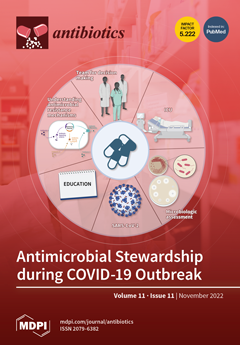The eradication of staphylococcal infections has become more difficult due to the development of antibiotic resistance and virulence in biofilm-forming
Staphylococcus aureus. The presence of the life-threatening zoonotic pathogen, methicillin-resistant
S. aureus (MRSA), in foods indicates a public health issue. This study, therefore, aimed to determine virulence factors and methicillin resistance in biofilm-forming
S. aureus isolates from different foods and food handlers. A total of 100 PCR-positive
S. aureus isolates (97 biofilm formers and three non-biofilm formers) were screened using the disk diffusion method and PCR assay. By PCR, genes encoding virulence factors, e.g., enterotoxin (
sea, 30%, 95% CI: 21.90–39.59%), toxic shock syndrome toxin (
tst, 20%, 95% CI: 13.34–28.88%), and Panton–Valentine leukocidin toxin (
PVL, 15%, 95% CI: 9.31–23.28%), were detected in the
S. aureus isolates. By the disk diffusion method, 100% (95% CI: 96.30–100.00%) of
S. aureus isolates were phenotypically MRSA in nature, showing 100% resistance to oxacillin and cefoxitin. Moreover, the methicillin-resistant gene
mecA was found in 61 (61%, 95% CI: 51.20–69.98%) MRSA isolates. Furthermore, all the
S. aureus isolates were phenotypically resistant to ampicillin and penicillin, 30% to erythromycin, and 11% to gentamycin. Among them, 51% (95% CI: 41.35–60.58%) of
S. aureus isolates were phenotypically multidrug-resistant in nature, and the multiple antibiotic resistance index varied from 0.33 to 0.55. Genes encoding resistance to beta-lactams (
blaZ, 100%, 95% CI: 96.30–100.00%) and tetracyclines (
tetA and
tetC, 3%, 95% CI: 0.82–8.45%) were found positive in the
S. aureus isolates. Genes encoding virulence determinants and MRSA were significantly (
p < 0.05) higher in strong biofilm-forming
S. aureus than in moderate and non-biofilm-forming isolates. To our knowledge, this is the first study in Bangladesh to incorporate preliminary data on the occurrence of virulence determinants and methicillin resistance, including resistance to clinically important antibiotics, in biofilm-forming
S. aureus isolates from different foods and food handlers in Bangladesh, emphasizing a potential threat to human health.
Full article






